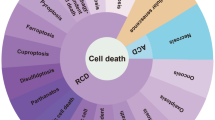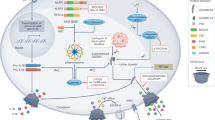Abstract
Dying cells subjected to apoptotic programs are engulfed by neighboring cells or by professional phagocytes, without inflammation or immunological reactions in the tissue where apoptosis takes place. Apoptotic cells release danger-associated project signals to their neighbours, through different molecular patterns, stimulate antigen production and immune responses. Microenvironmental effects with several functional consequences indicate that cell death is a complex process and may take place in several ways. This idea is expressed by the title of the Special Issue and by the title of the guest editorial “Mille modis morimur” meaning that not only multicellular organisms, but also single cells may die in a thousand ways. This idea is demonstrated by the papers serving as examples for cell death. Apoptosis was induced by clary sage oil in Candida cells. Heavy metal (Gd) induced cell motility and apoptosis was found in mammalian cells. RNA oxidation enhanced the reversion frequency of apoptosis in yeast mutants. The frequency of apoptotic micronucleus formation increased in a concentration-dependent manner by methotrexate. The antioxidant coenzyme Q10 protected renal proximal tubule cells against nicotine-induced apoptosis. The synergy of 2-deoxy-d-glucose combined with berberine induced lysosome/autophagy. The mitochondrial apoptotic pathway could be regulated by glucocorticoid receptor in collaboration with Bcl-2 family proteins in developing T cells. Cylindrospermopsin induced biochemical changes led to apoptosis in plants. Mechanisms of stress seriously impacted the risk of apoptosis. Transcriptional control of apoptotic cell clearance was achieved by macrophage nuclear receptors. Finally, the clinical aspects of apoptosis-induced lymphopenia were reviewed in sepsis and other severe injuries. These examples not only support the view of many ways of cell death, but predict further potential ways to induce or reduce the risk of cell death.

Similar content being viewed by others
References
Engelberg-Kulka H, Amitai S, Kolodkin-Gal I, Hazan R (2006) Bacterial programmed cell death and multicellular behavior in bacteria. PLoS Genet 2:e135. doi:10.1371/journal.pgen.0020135
Douglas RG (2011) Means to an end: apoptosis and other cell death mechanisms. Cold Spring Harbor Laboratory Press, Cold Spring Harbor
Schweichel JU, Merker HJ (1973) The morphology of various types of cell death in prenatal tissues. Teratology 7:253–266
Clarke PG (1990) Developmental cell death: morphological diversity and multiple mechanisms. Anat Embryol (Berl) 181:195–213
Bursch W (2001) The autophagosomal lysosomal compartment in programmed cell death. Cell Death Differ 8:569–581
Boya P, Reggiori F, Codogno P (2013) Emerging regulation and functions of autophagy. Nat Cell Biol 15:713–720
Kierszenbaum A (2012) Histology and cell biology: an introduction to pathology. Elsevier Saunders, Philadelphia
Majno G, Joris I (1995) Apoptosis, oncosis, and necrosis. An overview of cell death. Am J Pathol 146:3–15
Pasparakis M, Vandenabeele P (2015) Necroptosis and its role in inflammation. Nature 517:311–320
Dixon SJ, Lemberg KM, Lamprecht MR, Skouta R, Zaitsev EM, Gleason CE, Patel DN, Bauer AJ, Cantley AM, Yang WS, Morrison B III, Stockwell BR (2012) Ferroptosis: an iron-dependent form of non-apoptotic cell death. Cell 149:1060–1072
Coleman MP, Freeman MR (2010) Wallerian degeneration, wld(s), and nmnat. Annu Rev Neurosci 33:245–267
Zhang J, Xu X, Liu Y (2004) Activation-induced cell death in T cells and autoimmunity. Cell Mol Immunol 1:186–192
Melino G (2001) The Sirens’ song. Nature 412:423
Kroemer G, El-Deiry WS, Golstein P, Peter ME, Vaux D, Vandenabeele P, Zhivotovsky B, Blagosklonny MV, Malorni W, Knight RA, Piacentini M, Nagata S, Melino G (2005) Classification of cell death: recommendations of the nomenclature committee on cell death. Cell Death Differ 12(Suppl 2):1463–1467
Kroemer G, Galluzzi L, Vandenabeele P, Abrams J, Alnemri ES, Baehrecke EH, Blagosklonny MV, El-Deiry WS, Golstein P, Green DR, Hengartner M, Knight RA, Kumar S, Lipton SA, Malorni W, Nuñez G, Peter ME, Tschopp J, Yuan J, Piacentini M, Zhivotovsky B, Melino G. Classification of cell death: recommendations of the nomenclature committee on cell death 2009. Cell Death Differ 16:3–11
Galluzzi L, Vitale I, Abrams JM, Alnemri ES, Baehrecke EH, Blagosklonny MV, Dawson TM, Dawson VL, El-Deiry WS, Fulda S, Gottlieb E, Green DR, Hengartner MO, Kepp O, Knight RA, Kumar S, Lipton SA, Lu X, Madeo F, Malorni W, Mehlen P, Nuñez G, Peter ME, Piacentini M, Rubinsztein DC, Shi Y, Simon HU, Vandenabeele P, White E, Yuan J, Zhivotovsky B, Melino G, Kroemer G (2012) Molecular definitions of cell death subroutines: recommendations of the nomenclature committee on cell death 2012. Cell Death Differ 19:107–120
Ridley M (2003) Genes, experience, and what makes us human. In: Nature via nurture. Harper Collins Publishers Inc, New York
Rutter M (2006) Genes and behavior: nature-nurture interplay explained, vol V. Blackwell Publishers, Oxford, p 280
Cuhna F, Heckman JJ (2010) Investing in our young people. In: Reynolds AJ, Rolnick A, Englund MM, Temple J (eds) Cost-effective early childhood programs in the first decade: a human capital integration. Cambridge University Press, New York, p 381–414
Bröker LE, Kruyt FA, Giaccone G (2005) Cell death independent caspases: a review. Clin Cancer Res 11:3155–3162
Kerr J (1965) A histochemical study of hypertrophy and ischaemic injury of rat liver with special reference to changes in lysosomes. J Pathol Bacteriol 90:419–435
Kerr JF, Willie AH, Currie AR (1972) Apoptosis: a basic biological phenomenon with wide-ranging implications in tissue kinetics. Br J Cancer 26:239–257
Jacobson MD, Weil M, Raff MC (1997) Programmed cell death in animal development. Cell 88:347–354
Rathmell JC, Thompson CB (1999) The central effectors of cell death in the immune system. Annu Rev Immunol 17:781–828
Ginaldi L, De Martinis M, Monti D, Franceschi C (2005) Chronic antigenic load and apoptosis in immunofluorescence. Trend Immunol 26:79–84
Banfalvi G, Nagy G, Gacsi M, Roszer T, Basnakian AG (2006) Common pathway of chromosome condensation in mammalian cells. DNA Cell Biol 25:295–301
Banfalvi G (2014) Apoptotic agents inducing genotoxicity-specific chromatin changes. Apoptosis 19:1301–1316
Marton A, Mihalik R, Bratincsak A, Adleff V, Peták I, Vegh M, Bauer PI, Krajcsi P (1997) Apoptotic cell death induced by inhibitors of energy conservation–Bcl-2 inhibits apoptosis downstream of a fall of ATP level. Eur J Biochem 250:467–475
Lebiedzińska M, Suski J, Duszyński J, Wieckowski MR (2010) Role of the p66Shc protein in physiological state and in pathologies. Postepy Biochem 56:165–173
Reape TJ, Molony EM, McCabe PF (2008) Programmed cell death in plants: distinguishing between different modes. J Exp Bot 59:435–444
Penberthy KK, Ravichandran KS (2016) Apoptotic cell recognition receptors and scavenger receptors. Immunol Rev 269:44–59
Funding
The funding was provided by OTKA (Grant No. T 42762).
Author information
Authors and Affiliations
Corresponding author
Rights and permissions
About this article
Cite this article
Banfalvi, G. Mille modis morimur: We die in a thousand ways. Apoptosis 22, 169–174 (2017). https://doi.org/10.1007/s10495-016-1328-0
Published:
Issue Date:
DOI: https://doi.org/10.1007/s10495-016-1328-0




